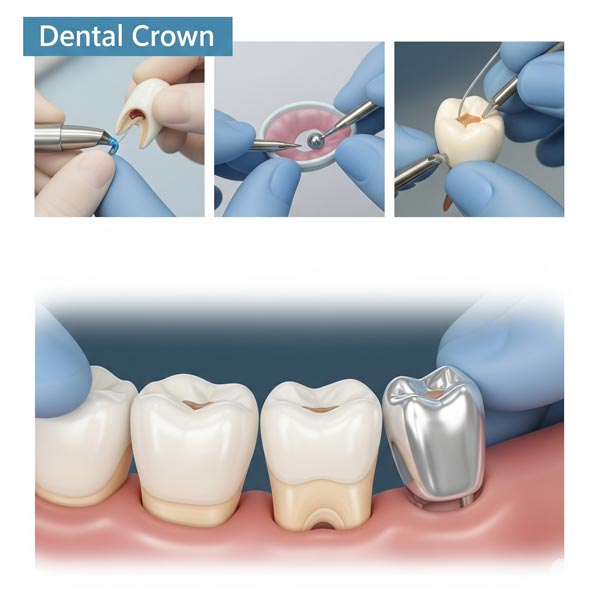A crown is basically a cap for a damaged tooth. It can be made from a variety of materials, including metal or porcelain
Several factors are important to consider when choosing a crown, including:
- Cost
- Strength
- Durability
Types of dental crowns
- Porcelain
- Ceramic
- Zirconia
- Metal
- Composite resin
When selecting the material for your crown, your dentist will consider factors such as:
- Your tooth’s location
- Position of your gum tissue
- Function of the tooth that needs the crown
- Color of the surrounding teeth
Temporary crown
A temporary crown is exactly what it sounds like. It’s a crown that’ll only remain in your mouth for a short period of time. Till the permanent crown arrive.
One-day crown
Some dental offices offer same-day crown installation using one of several methods involving computer-aided design/computer-aided manufacturing (CAD/CAM).
Onlay or 3/4 crown
Some crowns only cover a portion of the tooth. If you don’t need a full crown, your dentist might suggest an onlay or 3/4 crown instead.
Who needs a crown?
If you have a large cavity that’s too big for a filling, it may be time for a crown.
- severely worn down, cracked and weakened.
- Crowns are also recommended following a root canal on a tooth, because the tooth is more fragile and needs protection.
- You may be a candidate for a crown if you’re missing a tooth, and the dentist needs to put in a dental bridge or a tooth implant.
Dental crown procedure
With a traditional crown, you will need to visit your dentist’s office twice.
- The dentist examines and prepares the tooth that needs the crown. This might involve taking X-rays of the tooth. They also may take a mold of your tooth or mouth beforehand.
- An impression will be made of your trimmed tooth and the surrounding teeth.
- The dentist will put a temporary crown over your tooth to protect it.
- When the crown comes in, you’ll return for the second visit, so your dentist can cement the crown to your tooth.
With a same-day procedure, you can skip the temporary crown step.
- The dentist takes digital pictures of your mouth.
- Using the digital scan from the photos, the dentist creates the crown right there in the office. You may have to wait about 1 to 2 hours until the crown is made.
- Once the crown is ready, your dentist cements it into place. The entire process takes about 2 to 4 hours.
Dental crown care
Practice careful brushing and flossing. If you’re not already brushing your teeth twice a day, it’s time to start. Consider using a toothpaste for sensitive teeth if your crown or the teeth around it are sensitive to heat or cold.
Avoid hard foods. Chewing ice or hard foods might cause your crown to crack, especially if you have a porcelain crown.
Possible complications of having a crown
- Teeth sensitivity
- Chipped crown
- Crown knocked out or loose
- Gum disease
How long do dental crowns last?
The lifespan of a crown can vary between 5 and 15 years, some last longer





